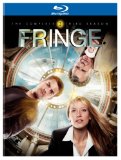| Reviews & Columns |
|
Reviews DVD TV on DVD Blu-ray 4K UHD International DVDs In Theaters Reviews by Studio Video Games Features Collector Series DVDs Easter Egg Database Interviews DVD Talk Radio Feature Articles Columns Anime Talk DVD Savant Horror DVDs The M.O.D. Squad Art House HD Talk Silent DVD
|
DVD Talk Forum |
|
|
| Resources |
|
DVD Price Search Customer Service #'s RCE Info Links |
|
Columns
|
|
|
Fringe: The Complete Third Season
Warner Bros. // Unrated // September 6, 2011
List Price: $69.97 [Buy now and save at Amazon]
The Season:
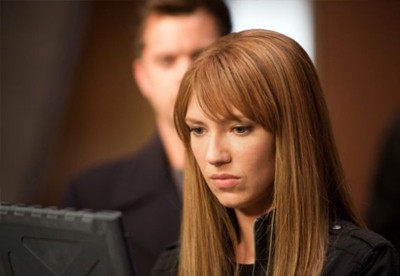 There comes a time in certain narrative-based TV series when the creators and writers realize -- or need to realize -- that they've crossed a threshold, similar to reading a second or third installment in a string of novels or watching a movie sequel. They're so deeply entrenched in the story that new audiences feel lost if they try and jump in mid-way, unless they choose to invest their time to backpedal and check out previous installments. Fringe, which has maintained something of a cult status amid its time-spot move to Friday nights, has reached that point; if the mention of Fauxlivia and Walternate or mercury-blooded shape-shifters and the perfect strawberry milkshake don't trigger some form of a response, then you're in the camp that'll feel bewildered. But the writers know who they're writing for at this point, and its loyal fans will feel at home in the continuation of the show's zany, intense sci-fi storyline, even if it hits a few implausible bumps that, yes, even this show can't fully support.
There comes a time in certain narrative-based TV series when the creators and writers realize -- or need to realize -- that they've crossed a threshold, similar to reading a second or third installment in a string of novels or watching a movie sequel. They're so deeply entrenched in the story that new audiences feel lost if they try and jump in mid-way, unless they choose to invest their time to backpedal and check out previous installments. Fringe, which has maintained something of a cult status amid its time-spot move to Friday nights, has reached that point; if the mention of Fauxlivia and Walternate or mercury-blooded shape-shifters and the perfect strawberry milkshake don't trigger some form of a response, then you're in the camp that'll feel bewildered. But the writers know who they're writing for at this point, and its loyal fans will feel at home in the continuation of the show's zany, intense sci-fi storyline, even if it hits a few implausible bumps that, yes, even this show can't fully support.
Last season (reviewed here) -- which ratcheted the series' quality up quite a few notches -- introduced us to the idea of an alternate universe where the Fringe Division, the folks who investigate and make sense of unexplainable supernatural occurrences, is a considerable government-funded force instead of a ragtag group in a Harvard basement laboratory, where stumbling scientist Walter Bishop (John Noble) is the Secretary of Defense and Olivia (Anna Torv) sports red hair and a more amicable demeanor. It's a world where the attacks on 9/11 didn't destroy the World Trade Center towers (instead hitting other targets), the Statue of Liberty radiates bronze instead of weathered aquamarine, zeppelins populate the sky, and the level of technology at-use is a few decades advanced from ours. In the midst of our discovery, we learn of a cloak-and-dagger war that's brewing between the two universes, with substantial supernatural events occurring in or around "soft spots" in the real world that interconnect the two. And the alternate universe seems to be taking the upper-hand, while Peter Bishop (Joshua Jackson) -- recently discovered to be born of the other side, transplanted to the prime universe -- struggles to figure out why his face is plastered all over doomsday documents that prophesize the end of days.
Sure, the conflict between the two sides and Peter's discovery of "the device" is important, the backbone to what's coming in Fringe, but at first it almost takes a backseat to a surface-level curiosity: what the hell is going on with the Olivias? (And it's at this point when the onslaught of previous season spoilers emerges). Season Two ended on a cliffhanger where the daring, red-haired Olivia (Fauxlivia) has infiltrated the prime universe as ... well, that universe's Olivia, while "our" Olivia has been tossed into solitary confinement in the alternate universe. That pretty much ensured interaction between the sides throughout the rest of this third season, yet the writing really surprises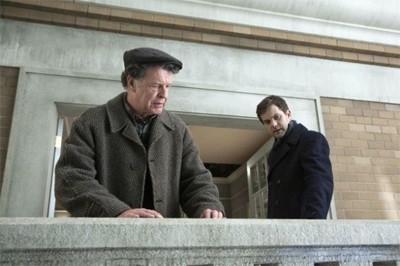 with exactly how judiciously they divide the material between them; while the series still continues on its case-an-episode rhythm as it ping-pongs between the different Fringe Divisions, they also focus on how Fauxlivia maintains a relationship with Peter and slips through the shadows as an informant and contact beacon for the devious shape-shifters, as well as exactly what's being done with Olivia on the other side. The follow-through is satisfying, outlandishly complex, and it keeps the intrigue up even once the situation eventually rights itself.
with exactly how judiciously they divide the material between them; while the series still continues on its case-an-episode rhythm as it ping-pongs between the different Fringe Divisions, they also focus on how Fauxlivia maintains a relationship with Peter and slips through the shadows as an informant and contact beacon for the devious shape-shifters, as well as exactly what's being done with Olivia on the other side. The follow-through is satisfying, outlandishly complex, and it keeps the intrigue up even once the situation eventually rights itself.
Splitting the episodes up between universes also has an unavoidable side-effect though, something that's a little tough to put a finger on until you get to the end of the season: shifting between the two worlds tends to dampen Fringe's suspense, arguably the show's strongest element. Here, the creators try to wrangle two veins of anticipation that, somewhat obviously, are going to converge later on, and what the show's runners don't realize -- or perhaps they do, and, yeah, they still try to make the most of it -- is that pausing one storyline to jump into another takes away some of the impact that hallmarks the series' thrust. That's not to say that each side doesn't have its momentum, which they both certainly do, but shifting gears on an episode-by-episode basis sucks some of the consistent tension out of the narrative progression. That comes with the territory when you're splitting the story's time between evenly-distributed arcs, and the courageous way that the writers not only address the series' alternate realm but aggressively explore the connections between the two makes up for the lacking suspense.
But the case-solving also doesn't generate quite the same caliber of curiosity this time around, due in large part to the dominant stream of storytelling. Some of that comes from an unswerving focus on what's going on with the inter-dimensional conflict, but it also comes from the scientific oddities not being as gripping or, put bluntly, explained as ornately or cleverly. There are a few exceptions: one episode, "The Plateau", focuses on an autistic man given treatments to bolster his mental processes, which leads to an unforeseen ability to mathematically predict -- and cause -- dangerous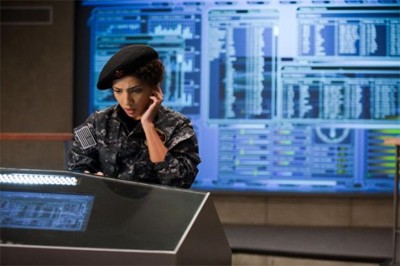 events that string together like dominos falling, and another, "Os", features a doctor (played by Ferris Bueller's Alan Ruck) trying to develop an experimental drug to help wheelchair-bound people walk (even fly), which requires certain impossible-to-find minerals that he must obtain by nefarious means. Even though both of these have plot holes marring them (gravity's a fickle thing that can apparently increase and decrease weight with a scene's needs), they're at least exciting and offer occasional ethical conflicts that spice things up, due in large part to Brad Anderson's direction in both. Others, from carving people out of amber and reanimating them to bone-liquefying gases and "haunted" buildings, aren't as catching as they appear on paper, even if the series' capabilities with shrewd dialogue and terse situations built around the events mask this waning interest.
events that string together like dominos falling, and another, "Os", features a doctor (played by Ferris Bueller's Alan Ruck) trying to develop an experimental drug to help wheelchair-bound people walk (even fly), which requires certain impossible-to-find minerals that he must obtain by nefarious means. Even though both of these have plot holes marring them (gravity's a fickle thing that can apparently increase and decrease weight with a scene's needs), they're at least exciting and offer occasional ethical conflicts that spice things up, due in large part to Brad Anderson's direction in both. Others, from carving people out of amber and reanimating them to bone-liquefying gases and "haunted" buildings, aren't as catching as they appear on paper, even if the series' capabilities with shrewd dialogue and terse situations built around the events mask this waning interest.
Thankfully, the underlying appeal that the characters generate while they're solving the macabre cases continues in Fringe (on both sides!). Anna Torv and Joshua Jackson deliver the same stern-eyed, occasionally amicable energy as the previous seasons as Olivia and Peter; their relationship becomes a heavy fixture, both involving the original Olivia and the fake Olivia, and the slight shift in Anna Torv's acting poise and Jackson's warming persona sells them both. Walter's mad-scientist idiosyncrasy, even though John Noble telegraphs the scripting in the same pitch-perfect fashion, teeters on the gimmicky side of things with just enough gusto to keep him in-line. His antics now border on being quirky for quirk's sake, sure, from lapping up jam that looks like blood to a penchant for taking off his pants. While Walter's eccentric demands for Astrid (Jasika Nicole) and attention-deficit proclamations are still fun and familiar, and Noble's delivery lends them authenticity without fault, it's as if the writers embellish his character to balance against the grim, devious "Walternate" (whom Noble also brings to snarling life). But he's so infectious to watch on-screen that it really doesn't matter. Everyone else, from the mysterious Massive Dynamic figurehead Nina Sharp (Blair Brown) to the auspiciously similar sides of FBI/Fringe Head Philip Broyles (Lance Reddick), maintain their reliably strong supportive roles with the occasional standout moment (just wait until you see Broyles blow bubbles).
This season even has its own '80s flashback episode, and, once again, it's one of the highlights; "Subject 13" does for Olivia's character what "Peter" did in the second season, injecting an empathetic rush of storytelling behind her backstory. We learn things about her as a young girl, her treatments, and the relationship she shared with Peter before they even met at Fringe Division. While not the impactful and series-defining event as last season's time-capsule episode, it gives us a glimpse at the events in Jacksonville that have only really been alluded to in previous episodes. Alongside that, it also explores Peter's mentality as a follow-up to the events that occurred during his "abduction" from the other side, as well as the way his parents cope with the situation. And it ends perfectly, showcasing the roots of some of the supernatural powers we've seen thus far for a gut-churning effect.
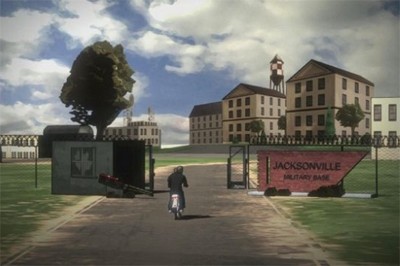 The first two-thirds so of Fringe's third season still, all points considered, delivers proportionately-acted, engaging science-fiction television that diligently mines the materials planted in the previous seasons, exploiting the mythos behind Peter's inextricable link to a doomsday device, Walternate's anger towards the prime universe, and the dueling Olivias. Then, starting with "Stowaway", things takes a turn for the bizarre. Now, Fringe is obviously no stranger to odd, harebrained events operating as the core of its story, but the subject matter here -- involving William Bell's consciousness from "beyond the grave", so to speak -- pushes the envelope of its science-fiction theorizing nearly beyond the show's threshold. Obviously I'm being vague in not revealing what happens, but needless to say it's a superfluous device that, of all things, ends in a literal acid-trip of an episode that mixes computer-generated animation with scenarios that bluntly ape Inception (and The Matrix).
The first two-thirds so of Fringe's third season still, all points considered, delivers proportionately-acted, engaging science-fiction television that diligently mines the materials planted in the previous seasons, exploiting the mythos behind Peter's inextricable link to a doomsday device, Walternate's anger towards the prime universe, and the dueling Olivias. Then, starting with "Stowaway", things takes a turn for the bizarre. Now, Fringe is obviously no stranger to odd, harebrained events operating as the core of its story, but the subject matter here -- involving William Bell's consciousness from "beyond the grave", so to speak -- pushes the envelope of its science-fiction theorizing nearly beyond the show's threshold. Obviously I'm being vague in not revealing what happens, but needless to say it's a superfluous device that, of all things, ends in a literal acid-trip of an episode that mixes computer-generated animation with scenarios that bluntly ape Inception (and The Matrix).
Fringe's escalating conclusion, which sees the fabric of both realities destabilizing in rapid and exciting fashion, tries to cultivate some of the abnormal seeds that it plants in these previous episodes: the ideas of truly unexplainable and unpredictable sciences, an omnipresent force, and the notion of a life driven by a higher purpose. Don't worry: the show doesn't get all Biblical or anything like that, even though you will see Walter Bishop clamoring to the rooftop of a church at one point in a desperate attempt to reach out to any force that will listen to him. But it does prove to be an unique, if forced backbone once the conclusion arises, which ... well, the jury's still out on how I feel about the wild mind-bender of a climax, which takes everything the show's creators have acclimated us to -- alternate realities, doomsday prophecies, the works -- and flips the volume up to 11. It's a culmination point, to be certain, that takes the series in an innovative direction that, like Peter Bishop even says this season, offers more questions than it does answers (even if it could've potentially doubled as a series finale, with a few tweaks). Are they answers that I'm looking forward to learning? Sure, but it's time to start drafting a conclusion and to concentrate on sticking the landing.
Check Out DVDTalk's Other Fringe Reviews: Season One (DVD) | Season Two (DVD)
The Blu-ray:
On the surface, everything appears to be business as usual with Warner Bros.' presentation of Fringe: The Complete Third Season, arriving in a four-disc slimline package designed very similarly to the previous offerings. A nice foldout Episode Guide offers brief descriptions of the season's installments (as well as whether they take place in the prime or alternate universes, or both), with a range of the show's clever promotional images adorning it. A semi-shiny cardboard slipcover replicates the top artwork, with a shot of the cast adorning the back.
Under the hood, however, WB have taken a few strides to enhance the viewing experience beyond the previous season, starting with eliminating the auto-start function at the beginning of each disc. Instead, they've utilized a marathon viewing framework that prompts the user to insert the next disc at the end of the last episode on each one, as well as enabling the disc to pick up where it was stopped/ejected upon the last playback. The menu also allows you to view and choose the entire range of episodes across the entire season from
Video and Audio:
Normally I start my reviews by chatting up how the discs look, and we'll of course get to that, but special attention needs to be paid to Warner Bros.' long-awaited shift to DTS-HD Master Audio tracks for their television series, especially for Fringe. Yep, you read that right: every episode arrives with a high-definition audio option instead of the limited (albeit totally satisfactory) Dolby Digital 5.1 arrangements, and it's the best the show has sounded -- either on the home-media format or, if my ears serve me well enough, when it was broadcast. The big difference here comes in the breadth of the subtle effects and the balance stricken between all the sound elements, with the dialogue pouring out cleaner, more slight noises in Walter's laboratory trickling in from the rear channels, and a complete lack of strain on the audio track making it appear much more capable. Fringe has always displayed a fine amount of punch in its sound design, though, and that continues here; the occasional explosion and gunshot, the ebb and flow of the energetic score, and the brusque verbal delivery all test the lower-frequency channel aggressively, as well as pushing on the upper-level shelf with plenty of vigor.
It's also not as paramount to readily chat up Fringe's visual properties this time around because WB's 1080p AVC-encoded treatments, despite the shift from VC-1 files, are more of what we've come to expect: mildly flawed in terms of contrast and a bit smooth in some facets, but colorful, well-detailed, and very faithful to the broadcast quality. Again, between five and six forty-minute episodes are crammed onto each disc, amounting to over four hours of content that has to wrestle with audio tracks and, in some cases, special features. But WB's up to the task with some really fine work in regards to close-up facial textures and garments, not to mention a graceful and self-aware focus on the show's often bright palette; you'll see splashes of color in Walter's laboratory that you forgot existed, while the mix of interior and exterior shots -- both in the prime universe and the more tech-savvy, often more colorful alternate universe -- stay steady and free of noise. Again, the typical issues arise, with some graying and overly-dark contrast clouding some details and general softness slipping into the picture periodically. But, mostly, Fringe once again looks extremely good on Blu-ray.
Special Features:
Unfortunately, the supplemental features for Fringe aren't as extensive as they have been or previous seasons, obvious first with the number of Commentaries available this time around: TWO, one for "The Plateau" and another for "Lysergic Acid Diethylamide". The two tracks aren't too shabby, though, and they cover two of the season's more intriguing, oddball episodes (whether you cared for them or not). Also, a Maximum Movie (Episode) Mode option is available for the episode "Os", where you'll have the opportunity to access and view materials in Picture-in-Picture windows that reveal behind-the-scenes and assembly footage alongside the episode itself. But it doesn't just stick to dropping the PiP in intermittently; the footage also intuitively scales to full-screen.
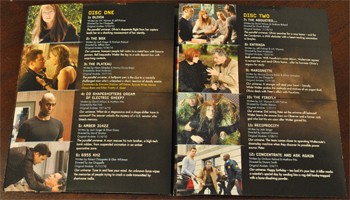 The bulk of the special features arrives on Disc Four, containing mostly a series of brief but insightful featurettes that last no longer than roughly ten minutes for each. The Duality of Worlds section explores both the theorized science and the show's visualization of the alternate world, revealing how they delve into the mindset of creating some of the tweaked-reality details (the difference in a $20 bill, buildings named after public figures, politicians with different pathways). The interviews with the cast and crew retrace familiar aggrandizing chatter, giving the art department and crew deserved praise, yet these pieces also offer crisply-shot behind-the-scenes moments alongside the sets. These include: The Other You (9:04, HD), Visualizing the Alternate World (8:22, HD), A Machine of Destiny (4:16, HD), and The Psychology of Duality (8:31, HD).
The bulk of the special features arrives on Disc Four, containing mostly a series of brief but insightful featurettes that last no longer than roughly ten minutes for each. The Duality of Worlds section explores both the theorized science and the show's visualization of the alternate world, revealing how they delve into the mindset of creating some of the tweaked-reality details (the difference in a $20 bill, buildings named after public figures, politicians with different pathways). The interviews with the cast and crew retrace familiar aggrandizing chatter, giving the art department and crew deserved praise, yet these pieces also offer crisply-shot behind-the-scenes moments alongside the sets. These include: The Other You (9:04, HD), Visualizing the Alternate World (8:22, HD), A Machine of Destiny (4:16, HD), and The Psychology of Duality (8:31, HD).
Moving on, the producers and crew gather together to discuss the show's impeccable sound design and music in Constructing an Extra-Sensory Soundscape (7:07, HD), where they discuss the weight of the scoring's accompaniment to the scenes and how the themes repurpose across different elements in the show (though I do wish more emphasis would've been placed on the actual recording of the sound effects). Continuing on the artistic/aesthetic rendering, Animating The Lysergic Acid Diethylamide Episode (7:33, HD) discusses why exactly they went the route of animation for this (and Leonard Nimoy's name, of course, gets a healthy amount of mention). To round things out, a Gag Reel (3:13, HD) lightens the mood and a brief feature entitled Secrets of Fringe: The First People (2:04) talks a bit about the potential for advanced societies long before ours.
Final Thoughts:
With its time-slot move to Friday nights, sometimes considered a death toll on FOX, Fringe has essentially gone for broke and started thinking outside-the-box for its loyal audience in this third season. There's no denying a few facts, though, as a result: while it still hits a gripping rhythm of suspense and scientific oddness that make it indelibly magnetic, it's also the most narrative-driven, inaccessible season to date for outside audiences. The content it explores -- alternate realities, alternate Olivias, doomsday prophecies, and ethically-demanding usage of abstract science -- offer reason enough to hammer through the previous seasons and venture headstrong into this one, though this third season won't earn any converts once the final third complicates the living daylights out of the Fringe universe. But it's such a wild, involving ride -- and really great episode-to-episode television -- that you can overlook some missteps for the sheer experience in getting wrapped up with the Fringe Division(s). It's not the strongest season, but it's definitely worth the time.
Warner Bros. probably could have continued their typical handling of Fringe and delivered the episodes with Dolby Digital tracks and the same auto-start functionality, hearing little about it, but they've instead elected to refine the presentation this time around. Arriving with high-definition audio and some enhancement in the episode functionality, alongside the typical visual quality, they've taken the experience in watching the physical up a few notches (even if they've backed away slightly from the special features). Highly Recommended to fans of the show, while newcomers will want to jump back and take a look at the two previous season beforehand.
Thomas Spurlin, Staff Reviewer -- DVDTalk Reviews | Personal Blog/Site
 There comes a time in certain narrative-based TV series when the creators and writers realize -- or need to realize -- that they've crossed a threshold, similar to reading a second or third installment in a string of novels or watching a movie sequel. They're so deeply entrenched in the story that new audiences feel lost if they try and jump in mid-way, unless they choose to invest their time to backpedal and check out previous installments. Fringe, which has maintained something of a cult status amid its time-spot move to Friday nights, has reached that point; if the mention of Fauxlivia and Walternate or mercury-blooded shape-shifters and the perfect strawberry milkshake don't trigger some form of a response, then you're in the camp that'll feel bewildered. But the writers know who they're writing for at this point, and its loyal fans will feel at home in the continuation of the show's zany, intense sci-fi storyline, even if it hits a few implausible bumps that, yes, even this show can't fully support.
There comes a time in certain narrative-based TV series when the creators and writers realize -- or need to realize -- that they've crossed a threshold, similar to reading a second or third installment in a string of novels or watching a movie sequel. They're so deeply entrenched in the story that new audiences feel lost if they try and jump in mid-way, unless they choose to invest their time to backpedal and check out previous installments. Fringe, which has maintained something of a cult status amid its time-spot move to Friday nights, has reached that point; if the mention of Fauxlivia and Walternate or mercury-blooded shape-shifters and the perfect strawberry milkshake don't trigger some form of a response, then you're in the camp that'll feel bewildered. But the writers know who they're writing for at this point, and its loyal fans will feel at home in the continuation of the show's zany, intense sci-fi storyline, even if it hits a few implausible bumps that, yes, even this show can't fully support. Last season (reviewed here) -- which ratcheted the series' quality up quite a few notches -- introduced us to the idea of an alternate universe where the Fringe Division, the folks who investigate and make sense of unexplainable supernatural occurrences, is a considerable government-funded force instead of a ragtag group in a Harvard basement laboratory, where stumbling scientist Walter Bishop (John Noble) is the Secretary of Defense and Olivia (Anna Torv) sports red hair and a more amicable demeanor. It's a world where the attacks on 9/11 didn't destroy the World Trade Center towers (instead hitting other targets), the Statue of Liberty radiates bronze instead of weathered aquamarine, zeppelins populate the sky, and the level of technology at-use is a few decades advanced from ours. In the midst of our discovery, we learn of a cloak-and-dagger war that's brewing between the two universes, with substantial supernatural events occurring in or around "soft spots" in the real world that interconnect the two. And the alternate universe seems to be taking the upper-hand, while Peter Bishop (Joshua Jackson) -- recently discovered to be born of the other side, transplanted to the prime universe -- struggles to figure out why his face is plastered all over doomsday documents that prophesize the end of days.
Sure, the conflict between the two sides and Peter's discovery of "the device" is important, the backbone to what's coming in Fringe, but at first it almost takes a backseat to a surface-level curiosity: what the hell is going on with the Olivias? (And it's at this point when the onslaught of previous season spoilers emerges). Season Two ended on a cliffhanger where the daring, red-haired Olivia (Fauxlivia) has infiltrated the prime universe as ... well, that universe's Olivia, while "our" Olivia has been tossed into solitary confinement in the alternate universe. That pretty much ensured interaction between the sides throughout the rest of this third season, yet the writing really surprises
 with exactly how judiciously they divide the material between them; while the series still continues on its case-an-episode rhythm as it ping-pongs between the different Fringe Divisions, they also focus on how Fauxlivia maintains a relationship with Peter and slips through the shadows as an informant and contact beacon for the devious shape-shifters, as well as exactly what's being done with Olivia on the other side. The follow-through is satisfying, outlandishly complex, and it keeps the intrigue up even once the situation eventually rights itself.
with exactly how judiciously they divide the material between them; while the series still continues on its case-an-episode rhythm as it ping-pongs between the different Fringe Divisions, they also focus on how Fauxlivia maintains a relationship with Peter and slips through the shadows as an informant and contact beacon for the devious shape-shifters, as well as exactly what's being done with Olivia on the other side. The follow-through is satisfying, outlandishly complex, and it keeps the intrigue up even once the situation eventually rights itself. Splitting the episodes up between universes also has an unavoidable side-effect though, something that's a little tough to put a finger on until you get to the end of the season: shifting between the two worlds tends to dampen Fringe's suspense, arguably the show's strongest element. Here, the creators try to wrangle two veins of anticipation that, somewhat obviously, are going to converge later on, and what the show's runners don't realize -- or perhaps they do, and, yeah, they still try to make the most of it -- is that pausing one storyline to jump into another takes away some of the impact that hallmarks the series' thrust. That's not to say that each side doesn't have its momentum, which they both certainly do, but shifting gears on an episode-by-episode basis sucks some of the consistent tension out of the narrative progression. That comes with the territory when you're splitting the story's time between evenly-distributed arcs, and the courageous way that the writers not only address the series' alternate realm but aggressively explore the connections between the two makes up for the lacking suspense.
But the case-solving also doesn't generate quite the same caliber of curiosity this time around, due in large part to the dominant stream of storytelling. Some of that comes from an unswerving focus on what's going on with the inter-dimensional conflict, but it also comes from the scientific oddities not being as gripping or, put bluntly, explained as ornately or cleverly. There are a few exceptions: one episode, "The Plateau", focuses on an autistic man given treatments to bolster his mental processes, which leads to an unforeseen ability to mathematically predict -- and cause -- dangerous
 events that string together like dominos falling, and another, "Os", features a doctor (played by Ferris Bueller's Alan Ruck) trying to develop an experimental drug to help wheelchair-bound people walk (even fly), which requires certain impossible-to-find minerals that he must obtain by nefarious means. Even though both of these have plot holes marring them (gravity's a fickle thing that can apparently increase and decrease weight with a scene's needs), they're at least exciting and offer occasional ethical conflicts that spice things up, due in large part to Brad Anderson's direction in both. Others, from carving people out of amber and reanimating them to bone-liquefying gases and "haunted" buildings, aren't as catching as they appear on paper, even if the series' capabilities with shrewd dialogue and terse situations built around the events mask this waning interest.
events that string together like dominos falling, and another, "Os", features a doctor (played by Ferris Bueller's Alan Ruck) trying to develop an experimental drug to help wheelchair-bound people walk (even fly), which requires certain impossible-to-find minerals that he must obtain by nefarious means. Even though both of these have plot holes marring them (gravity's a fickle thing that can apparently increase and decrease weight with a scene's needs), they're at least exciting and offer occasional ethical conflicts that spice things up, due in large part to Brad Anderson's direction in both. Others, from carving people out of amber and reanimating them to bone-liquefying gases and "haunted" buildings, aren't as catching as they appear on paper, even if the series' capabilities with shrewd dialogue and terse situations built around the events mask this waning interest. Thankfully, the underlying appeal that the characters generate while they're solving the macabre cases continues in Fringe (on both sides!). Anna Torv and Joshua Jackson deliver the same stern-eyed, occasionally amicable energy as the previous seasons as Olivia and Peter; their relationship becomes a heavy fixture, both involving the original Olivia and the fake Olivia, and the slight shift in Anna Torv's acting poise and Jackson's warming persona sells them both. Walter's mad-scientist idiosyncrasy, even though John Noble telegraphs the scripting in the same pitch-perfect fashion, teeters on the gimmicky side of things with just enough gusto to keep him in-line. His antics now border on being quirky for quirk's sake, sure, from lapping up jam that looks like blood to a penchant for taking off his pants. While Walter's eccentric demands for Astrid (Jasika Nicole) and attention-deficit proclamations are still fun and familiar, and Noble's delivery lends them authenticity without fault, it's as if the writers embellish his character to balance against the grim, devious "Walternate" (whom Noble also brings to snarling life). But he's so infectious to watch on-screen that it really doesn't matter. Everyone else, from the mysterious Massive Dynamic figurehead Nina Sharp (Blair Brown) to the auspiciously similar sides of FBI/Fringe Head Philip Broyles (Lance Reddick), maintain their reliably strong supportive roles with the occasional standout moment (just wait until you see Broyles blow bubbles).
This season even has its own '80s flashback episode, and, once again, it's one of the highlights; "Subject 13" does for Olivia's character what "Peter" did in the second season, injecting an empathetic rush of storytelling behind her backstory. We learn things about her as a young girl, her treatments, and the relationship she shared with Peter before they even met at Fringe Division. While not the impactful and series-defining event as last season's time-capsule episode, it gives us a glimpse at the events in Jacksonville that have only really been alluded to in previous episodes. Alongside that, it also explores Peter's mentality as a follow-up to the events that occurred during his "abduction" from the other side, as well as the way his parents cope with the situation. And it ends perfectly, showcasing the roots of some of the supernatural powers we've seen thus far for a gut-churning effect.
 The first two-thirds so of Fringe's third season still, all points considered, delivers proportionately-acted, engaging science-fiction television that diligently mines the materials planted in the previous seasons, exploiting the mythos behind Peter's inextricable link to a doomsday device, Walternate's anger towards the prime universe, and the dueling Olivias. Then, starting with "Stowaway", things takes a turn for the bizarre. Now, Fringe is obviously no stranger to odd, harebrained events operating as the core of its story, but the subject matter here -- involving William Bell's consciousness from "beyond the grave", so to speak -- pushes the envelope of its science-fiction theorizing nearly beyond the show's threshold. Obviously I'm being vague in not revealing what happens, but needless to say it's a superfluous device that, of all things, ends in a literal acid-trip of an episode that mixes computer-generated animation with scenarios that bluntly ape Inception (and The Matrix).
The first two-thirds so of Fringe's third season still, all points considered, delivers proportionately-acted, engaging science-fiction television that diligently mines the materials planted in the previous seasons, exploiting the mythos behind Peter's inextricable link to a doomsday device, Walternate's anger towards the prime universe, and the dueling Olivias. Then, starting with "Stowaway", things takes a turn for the bizarre. Now, Fringe is obviously no stranger to odd, harebrained events operating as the core of its story, but the subject matter here -- involving William Bell's consciousness from "beyond the grave", so to speak -- pushes the envelope of its science-fiction theorizing nearly beyond the show's threshold. Obviously I'm being vague in not revealing what happens, but needless to say it's a superfluous device that, of all things, ends in a literal acid-trip of an episode that mixes computer-generated animation with scenarios that bluntly ape Inception (and The Matrix). Fringe's escalating conclusion, which sees the fabric of both realities destabilizing in rapid and exciting fashion, tries to cultivate some of the abnormal seeds that it plants in these previous episodes: the ideas of truly unexplainable and unpredictable sciences, an omnipresent force, and the notion of a life driven by a higher purpose. Don't worry: the show doesn't get all Biblical or anything like that, even though you will see Walter Bishop clamoring to the rooftop of a church at one point in a desperate attempt to reach out to any force that will listen to him. But it does prove to be an unique, if forced backbone once the conclusion arises, which ... well, the jury's still out on how I feel about the wild mind-bender of a climax, which takes everything the show's creators have acclimated us to -- alternate realities, doomsday prophecies, the works -- and flips the volume up to 11. It's a culmination point, to be certain, that takes the series in an innovative direction that, like Peter Bishop even says this season, offers more questions than it does answers (even if it could've potentially doubled as a series finale, with a few tweaks). Are they answers that I'm looking forward to learning? Sure, but it's time to start drafting a conclusion and to concentrate on sticking the landing.
The Blu-ray:
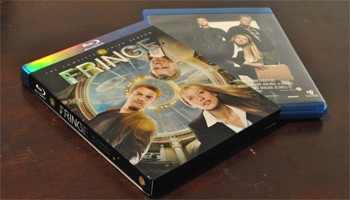 | 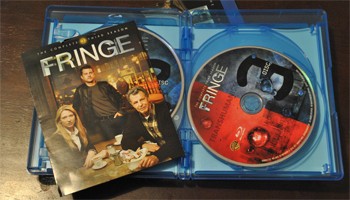 |
On the surface, everything appears to be business as usual with Warner Bros.' presentation of Fringe: The Complete Third Season, arriving in a four-disc slimline package designed very similarly to the previous offerings. A nice foldout Episode Guide offers brief descriptions of the season's installments (as well as whether they take place in the prime or alternate universes, or both), with a range of the show's clever promotional images adorning it. A semi-shiny cardboard slipcover replicates the top artwork, with a shot of the cast adorning the back.
Under the hood, however, WB have taken a few strides to enhance the viewing experience beyond the previous season, starting with eliminating the auto-start function at the beginning of each disc. Instead, they've utilized a marathon viewing framework that prompts the user to insert the next disc at the end of the last episode on each one, as well as enabling the disc to pick up where it was stopped/ejected upon the last playback. The menu also allows you to view and choose the entire range of episodes across the entire season from
Video and Audio:
Normally I start my reviews by chatting up how the discs look, and we'll of course get to that, but special attention needs to be paid to Warner Bros.' long-awaited shift to DTS-HD Master Audio tracks for their television series, especially for Fringe. Yep, you read that right: every episode arrives with a high-definition audio option instead of the limited (albeit totally satisfactory) Dolby Digital 5.1 arrangements, and it's the best the show has sounded -- either on the home-media format or, if my ears serve me well enough, when it was broadcast. The big difference here comes in the breadth of the subtle effects and the balance stricken between all the sound elements, with the dialogue pouring out cleaner, more slight noises in Walter's laboratory trickling in from the rear channels, and a complete lack of strain on the audio track making it appear much more capable. Fringe has always displayed a fine amount of punch in its sound design, though, and that continues here; the occasional explosion and gunshot, the ebb and flow of the energetic score, and the brusque verbal delivery all test the lower-frequency channel aggressively, as well as pushing on the upper-level shelf with plenty of vigor.
It's also not as paramount to readily chat up Fringe's visual properties this time around because WB's 1080p AVC-encoded treatments, despite the shift from VC-1 files, are more of what we've come to expect: mildly flawed in terms of contrast and a bit smooth in some facets, but colorful, well-detailed, and very faithful to the broadcast quality. Again, between five and six forty-minute episodes are crammed onto each disc, amounting to over four hours of content that has to wrestle with audio tracks and, in some cases, special features. But WB's up to the task with some really fine work in regards to close-up facial textures and garments, not to mention a graceful and self-aware focus on the show's often bright palette; you'll see splashes of color in Walter's laboratory that you forgot existed, while the mix of interior and exterior shots -- both in the prime universe and the more tech-savvy, often more colorful alternate universe -- stay steady and free of noise. Again, the typical issues arise, with some graying and overly-dark contrast clouding some details and general softness slipping into the picture periodically. But, mostly, Fringe once again looks extremely good on Blu-ray.
Special Features:
Unfortunately, the supplemental features for Fringe aren't as extensive as they have been or previous seasons, obvious first with the number of Commentaries available this time around: TWO, one for "The Plateau" and another for "Lysergic Acid Diethylamide". The two tracks aren't too shabby, though, and they cover two of the season's more intriguing, oddball episodes (whether you cared for them or not). Also, a Maximum Movie (Episode) Mode option is available for the episode "Os", where you'll have the opportunity to access and view materials in Picture-in-Picture windows that reveal behind-the-scenes and assembly footage alongside the episode itself. But it doesn't just stick to dropping the PiP in intermittently; the footage also intuitively scales to full-screen.
 The bulk of the special features arrives on Disc Four, containing mostly a series of brief but insightful featurettes that last no longer than roughly ten minutes for each. The Duality of Worlds section explores both the theorized science and the show's visualization of the alternate world, revealing how they delve into the mindset of creating some of the tweaked-reality details (the difference in a $20 bill, buildings named after public figures, politicians with different pathways). The interviews with the cast and crew retrace familiar aggrandizing chatter, giving the art department and crew deserved praise, yet these pieces also offer crisply-shot behind-the-scenes moments alongside the sets. These include: The Other You (9:04, HD), Visualizing the Alternate World (8:22, HD), A Machine of Destiny (4:16, HD), and The Psychology of Duality (8:31, HD).
The bulk of the special features arrives on Disc Four, containing mostly a series of brief but insightful featurettes that last no longer than roughly ten minutes for each. The Duality of Worlds section explores both the theorized science and the show's visualization of the alternate world, revealing how they delve into the mindset of creating some of the tweaked-reality details (the difference in a $20 bill, buildings named after public figures, politicians with different pathways). The interviews with the cast and crew retrace familiar aggrandizing chatter, giving the art department and crew deserved praise, yet these pieces also offer crisply-shot behind-the-scenes moments alongside the sets. These include: The Other You (9:04, HD), Visualizing the Alternate World (8:22, HD), A Machine of Destiny (4:16, HD), and The Psychology of Duality (8:31, HD). Moving on, the producers and crew gather together to discuss the show's impeccable sound design and music in Constructing an Extra-Sensory Soundscape (7:07, HD), where they discuss the weight of the scoring's accompaniment to the scenes and how the themes repurpose across different elements in the show (though I do wish more emphasis would've been placed on the actual recording of the sound effects). Continuing on the artistic/aesthetic rendering, Animating The Lysergic Acid Diethylamide Episode (7:33, HD) discusses why exactly they went the route of animation for this (and Leonard Nimoy's name, of course, gets a healthy amount of mention). To round things out, a Gag Reel (3:13, HD) lightens the mood and a brief feature entitled Secrets of Fringe: The First People (2:04) talks a bit about the potential for advanced societies long before ours.
Final Thoughts:
With its time-slot move to Friday nights, sometimes considered a death toll on FOX, Fringe has essentially gone for broke and started thinking outside-the-box for its loyal audience in this third season. There's no denying a few facts, though, as a result: while it still hits a gripping rhythm of suspense and scientific oddness that make it indelibly magnetic, it's also the most narrative-driven, inaccessible season to date for outside audiences. The content it explores -- alternate realities, alternate Olivias, doomsday prophecies, and ethically-demanding usage of abstract science -- offer reason enough to hammer through the previous seasons and venture headstrong into this one, though this third season won't earn any converts once the final third complicates the living daylights out of the Fringe universe. But it's such a wild, involving ride -- and really great episode-to-episode television -- that you can overlook some missteps for the sheer experience in getting wrapped up with the Fringe Division(s). It's not the strongest season, but it's definitely worth the time.
Warner Bros. probably could have continued their typical handling of Fringe and delivered the episodes with Dolby Digital tracks and the same auto-start functionality, hearing little about it, but they've instead elected to refine the presentation this time around. Arriving with high-definition audio and some enhancement in the episode functionality, alongside the typical visual quality, they've taken the experience in watching the physical up a few notches (even if they've backed away slightly from the special features). Highly Recommended to fans of the show, while newcomers will want to jump back and take a look at the two previous season beforehand.
|
| Popular Reviews |
| Sponsored Links |
|
|
| Sponsored Links |
|
|
| Release List | Reviews | Shop | Newsletter | Forum | DVD Giveaways | Blu-Ray | Advertise |
|
Copyright 2024 DVDTalk.com All Rights Reserved. Legal Info, Privacy Policy, Terms of Use,
Manage Preferences,
Your Privacy Choices | |||||||









